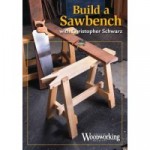We may receive a commission when you use our affiliate links. However, this does not impact our recommendations.

Getting the four feet of a sawbench, chair or stool all in the same plane is a challenge for some woodworkers. You can end up nibbling a bar stool into an ottoman if you take the wrong approach.
I’m sure there is some way to do this with the power of math, triangles and unicorn poo, but this is how I was taught to do it by chairmaker David Fleming. There is no math. No measuring. And it works every time.
The sawbench shown in the video was a birthday gift from a friend who ran out of time before he leveled the legs. The music is from freeplaymusic.com and is the song “From Little Rock to Glasgow.”
— Christopher Schwarz
Want to Make a Sawbench?
 We filmed one of my classes in making a super-handy sawbench using 2 x 6 pine. The DVD is available in our store and is one of our best-sellers: “Build a Sawbench with Christopher Schwarz.”
We filmed one of my classes in making a super-handy sawbench using 2 x 6 pine. The DVD is available in our store and is one of our best-sellers: “Build a Sawbench with Christopher Schwarz.”
Here are some supplies and tools we find essential in our everyday work around the shop. We may receive a commission from sales referred by our links; however, we have carefully selected these products for their usefulness and quality.









Dear Sir or Madame:
From the comments associated with this post, there has been a problem associated with this video for over a year and a half.
@##&%&#, you own your audience, subscribers, etc. better service than this.
Please get your s&#t together!
Video still not available for me to view, whats wrong? or am I missing something?
OMG ! Where is “Lataxe” from the old Fine Woodworking blog site when you need him !
I love video tips like this one, because I know that you should make you legs to long, then cut for level.
I have not done it so many times it would make you cry and a video like this one just reminds me how much easier it is to do it right.
All good unless the seat is not intended to sit level, as in most chairs.
Does it also work to use a circular level (about $1.50 at Sears) place on a flat board atop the stool? Seems like this would obviate the need to keep moving the level across multiple axes. I suppose that if the through tenons aren’t cut yet you might have a problem getting a good support for the board, though. Just a thought.
If the workbench is reasonably flat and three legs are on the bench. Use the workbench edge as a reference to mark the fourth leg that is draped off the side of the workbench. Works every time!
I have actually sawed the leg with a flush cut Japanese saw using the flat surface as the guide.
ditto…..file not playable………….get those cybespace gurus working……….or maybe a very large glen h hammer………
Hi Chris,
Love the blog … but can’t seem to play the “leveling a saw bench” video. It says “Oh noes! No playable files in the feed …”. But I’d like to …
Great tip. Here’s one on leveling: Don’t place the level parallel and then perpendicular to the chair axis.
Instead, place the level diagonally over two opposite legs. Level the bench in that axis. Then, place it perpendicular to the first location. Level the other two legs. Done. The leveling operations are independent of each other.
The way you did it, one operation affects the other.
I think you meant axis, not axes, cause that would be really hard to level to two axes.
Hi Chris,
I actually created an account just to comment on your method. It certainly works. I have been using a much simpler method for benches and stools that has always worked for me.
First I turn the stool upside down on a know reference surface (workbench). Then I cut a scrap as long as I want the stool high. I hold the scrap up to each leg, resting on the bench, and mark the outside corners. Connect the marks with a straightedge and cut away. No levels involved.
Peace,
Harlan Barnhart
Nice video and great trick!
I am not a fan of any technique that involves maths, but I reckon a little unicorn poo can never hurt! The problem seems to be getting the real thing these days. Most commercially available “danish unicorn poos” don’t actually contain any poo. Caveat emptor.